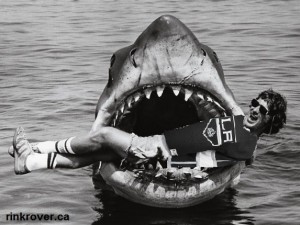What is it about Discovery Channel’s Shark Week that makes it so popular? TV audiences love the footage of sharks hunting their prey and showing off the raw power they have in the water. The internet explodes in its fandom in the days approaching the iconic week in August. Maybe people just really, REALLY like these big fish. After all, the Jaws movies still captivate the audiences of the new millennium. Could there be something like a hockey Shark Week?
As the country celebrates TV’s Shark Week, the NHL has developed its own version. In San Jose, there is a hockey Shark Week. Except fans go crazy for these Sharks all year long. In fact, playing in San Jose was once voted the toughest place to play by the athletes themselves.
When Did Hockey Shark Week Start?
Hockey in the Bay Area was not always a roaring success. 37 years ago, the California Golden Seals, who were based in Oakland, left for Cleveland and eventually folded and disappeared altogether. The team’s departure was met with no more than a shrug from the people of Northern California, with the exception of the diehard fans of course. Many were unaware that hockey even existed that close to them.
The other teams in the area hoarded all the fans for themselves. Football teams had boasted recent success and championships down the road. The 49ers had finally started to win in the 70s and the Raiders in Oakland actually won it all the year the Seals left. And baseball was even more of a fan magnet. The Oakland Athletics had just won three World Series titles in a row.
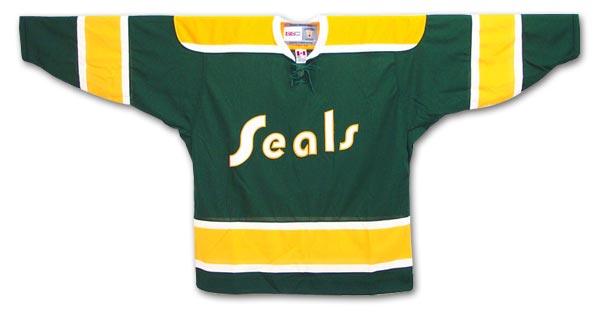
In short, the sports fans in the Bay Area had no time and no desire to watch a struggling new franchise in a sport few had ever played. The Seals never found a real home and soon were evicted.
When hockey returned to the Bay Area in 1991, it got off to an ironic and quiet start. The Sharks played in a facility called the Cow Palace. A modified hangar just outside of San Francisco. Their first two years were predictable, they led the league in losses. But in 1993-94, hockey Shark Week exploded.
1994 Western Conference Quarterfinals
Was it a coincidence that they moved to San Jose in 1994 and found success? In one of the largest turnarounds in history, the Sharks gained 58 points more than the season prior. The Sharks snuck into their first playoff series but were met by the HEAVILY favored Detroit Red Wings. The Wings were a perennial playoff team (and still are) having only missed the postseason twice in the ten years prior. They were favored to hoist the Cup that year. But in a stunning series, the Sharks took down the favorites in seven games. Jamie Baker scored in the third period as Chris Osgood gifted the expansion team with its first series win in its first attempt.
Why Does Everyone in the Bay Love Them?
Believe it or not, this has something to do with the choice of the team’s colors. When one thinks about it, teal is not the color that comes to mind in connection with intimidation. Turns out, teal is a better shade of blue to appeal to women, and when mixed with black, men love it too.
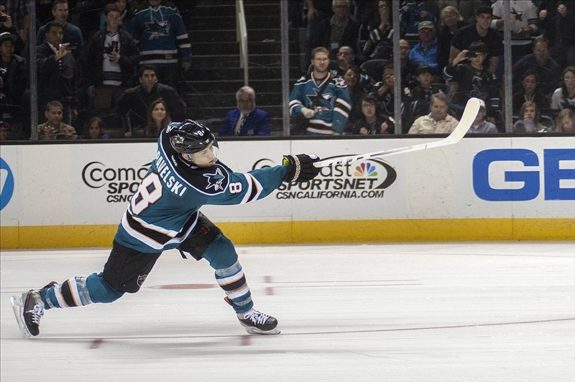
Now, it is not all about the color, of course. The geographical location of the arena places the team in downtown San Jose in a well-kept rink. There is tons of mass transit right across the street and the end of games see floods of fans walking in the other direction of the parking lot. And when bus lines, trains of different kinds and freeways all converge on one spot, getting to Sharks games becomes very easy.
Being located in the South Bay also takes away competition from other sports. Many teams call the Bay Area home. Six other major sports teams, the Giants, Athletics (MLB), 49ers, Raiders (NFL), Warriors (NBA), and the Earthquakes (MLS) are based in the three major cities. The 49ers move to neighboring Santa Clara next year, but Sundays and Mondays are quiet in the time when the seasons overlap. In fact, only a Monday night game on December 23rd has the two teams playing at the same time with both in town.
Fanatics in California
The largest contributor to fan attendance is obviously team success. It is an aspect that the Sharks have boasted for the better part of their twenty years in California. Since 2006-07, the Sharks have had at least 99.5% of their seats filled every night. The organization even bounced back well after the lockout in 2004-05 when in 2003-04 they nearly fell below 90%. It should come as no surprise that the 2003-04 season was the last time the Sharks missed the playoffs.
But another part of the huge fandom is owed to the Sharks biggest rivals. Hockey Shark Week employs the stalking of Ducks and Kings. Especially after the grinding playoff series with LA, the NHL noticed how California had come a long way in its hockey maturity. Battles with Jonathan Quick and Corey Perry down south make for great entertainment.
“…to be here tonight and see the crowd, it all demonstrates that hockey is thriving in California.” –Commissioner Bettman after Game 7 of the WC Semis
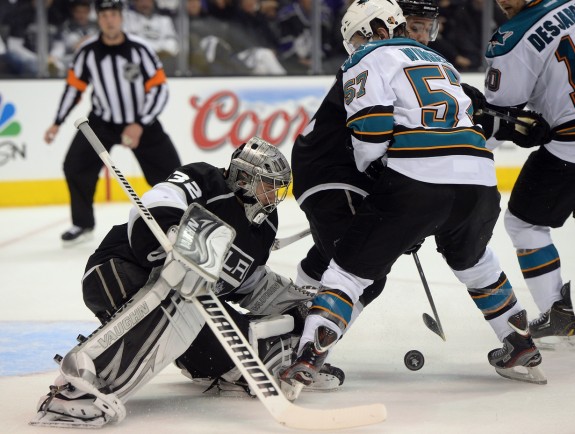
The Sharks also take a page out of Minnesota’s book and hook new players at young ages. In June, the organization was named one of the nation’s model programs. The Junior Sharks are now starting to produce players that make an impact in the NHL. At least 8 players in the NHL came from the Jr. Sharks program. Sharks Ice is the largest ice facility west of the Mississippi River with four surfaces under one roof. The adult hockey program boasts over 4,500 participants (1,000 more than the next largest).
The NHL’s Shark Week
The fans in San Jose make the team as strong as they are. Their arena is always packed and loud. The fans could be argued as a reason for the Sharks un-paralled success at home last season. They play the sport themselves and love to see their club always contend. Even through the frustrations of never reaching the Stanley Cup Finals despite being contenders every year, the fans stick by their Sharks. Granted it is a much nicer problem to have than never making the playoffs at all (*cough* Edmonton). San Jose loves their team, arguably they love them as much as hockey-crazy towns do. But, in a state where there is so much competition for their attention and the weather mostly sunshine, the fans still flock to the rink.
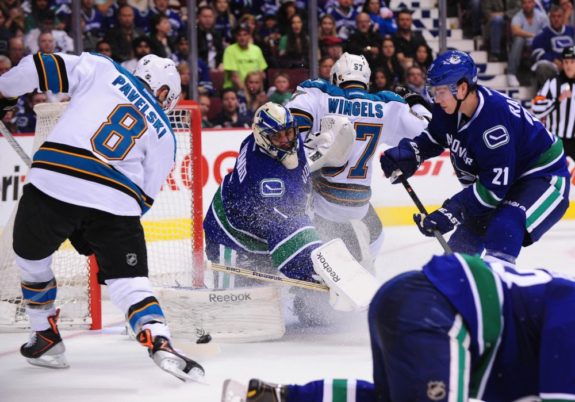
Even though San Jose nearly cracks the one million mark in population, the city still holds a distinct vibe and has an identity all its own. The Sharks represent Silicon Valley, the brains and center of tech in the US. It is appropriate then to have a front office that can build a competitive team year-in-year-out even when stars age out. GM Doug Wilson just secured a competitive future after Thornton and Marleau retire in the coming seasons. The Sharks playoff streak is likely going to remain intact and the fans will likely remain as rabid as ever.
